#ancient Thessaly
Explore tagged Tumblr posts
Text

Olympus: The Fall of the Giants (Battle of the Titans)
by Francisco Bayeu y Subías
#olympus#gods#war#battle#giants#titans#art#mount olympus#olympians#greek mythology#mythology#mythological#history#europe#european#jupiter#titanomachy#ancient greece#ancient greek#ancient thessaly#thessaly#greece#gigantes#cronus#zeus#cyclopes#ancient#antiquity#neoclassical#mediterranean
142 notes
·
View notes
Note
Hi Dr Reames!
Would you say that Macedon shared the same "political culture" with its Thracian and Illyrian neighbours, like how most Greeks shared the polis structure and the concept of citizenship?
I don't really know anything about Macedonian history before Philip II's time, but you've often brought up how the Macedonians shared some elements of elite culture (e.g. mound burials) with their Thracian neighbours, as well religious beliefs and practices.
I've only ever heard these people generically described as "a collection of tribes (that confederated into a kingdom)", which also seems to be the common description for nearby "Greek" polities like Thessaly and Epiros. So did these societies have a lot in common, structurally speaking, with Macedon? Or were they just completely different types of polities altogether?
First, in the interest of some good bibliography on the Thracians:
Z. H. Archibald, The Odrysian Kingdom of Thrace. Orpheus Unmasked. Oxford UP, 1998. (Too expensive outside libraries, but highly recommended if you can get it by interlibrary loan. Part of the exorbitant cost [almost $400, but used for less] owes to images, as it’s archaeology heavy. Archibald is also an expert on trade and economy in north Greece and the Black Sea region, and has edited several collections on the topic.
Alexander Fol, Valeria Fol. Thracians. Coronet Books, 2005. Also expensive, if not as bad, and meant for the general public. Fol’s 1977 Thrace and the Thracians, with Ivan Marazov, was a classic. Fol and Marazov are fathers of modern Thracian studies.
R. F. Hodinott, The Thracians. Thames and Hudson, 1981. Somewhat dated now but has pictures and can be found used for a decent price if you search around. But, yeah…dated.
For Illyria, John Wilkes’ The Illyrians, Wiley-Blackwell, 1996, is a good place to start, but there’s even less about them in book form (or articles).
—————
Now, to the question.
BOTH the Thracians and Illyrians were made up of politically independent tribes bound by language and religion who, sometimes, also united behind a strong ruler (the Odrysians in Thrace for several generations, and Bardylis briefly in Illyria). One can probably make parallels to Germanic tribes, but it’s easier for me to point to American indigenous nations. The Odrysians might be compared to the Iroquois federation. The Illyrians to the Great Lakes people, united for a while behind Tecumseh, but not entirely, and disunified again after. These aren’t perfect, but you get the idea. For that matter, the Greeks themselves weren’t a nation, but a group of poleis bonded by language, culture, and religion. They fought as often as they cooperated. The Persian invasion forced cooperation, which then dissolved into the Peloponnesian War.
Beyond linguistic and religious parallels, sometimes we also have GEOGRAPHIC ones. So, let me divide the north into lowlands and highlands. It’s much more visible on the ground than from a map, but Epiros, Upper Macedonia, and Illyria are all more alike, landscape-wise, than Lower Macedonia and the Thracian valleys. South of all that, and different yet again, lay Thessaly, like a bridge between Southern Greece and these northern regions.
If language (and religion) are markers of shared culture, culture can also be shaped by ethnically distinct neighbors. Thracians and Macedonians weren’t ethnically related, yet certainly shared cultural features. Without falling into colonialist geographical/environmental determinism, geography does affect how early cultures develop because of what resources are available, difficulties of travel, weather, lay of the land itself, etc.
For instance, the Pindus Range, while not especially high, is rocky and made a formidable barrier to easy east-west travel. Until recently, sailing was always more efficient in Greece than travel by land (especially over mountain ranges).* Ergo, city-states/towns on the western coast tended to be western-facing for trade, and city-states/towns on the eastern side were, predictably, eastern-facing. This is why both Epiros and Ainai (Elimeia) did more trade with Corinth than Athens, and one reason Alexandros of Epiros went west to Italy while Alexander of Macedon looked east to Persia. It’s also why Corinth, Sparta, etc., in the Peloponnese colonized Sicily and S. Italy, while Athens, Euboia, etc., colonized the Asia Minor and Black Sea coasts. (It’s not an absolute, but one certainly sees trends.)
So, looking at their land, we can see why Macedonians and Thracians were both horse people with their wide valleys. They also practiced agriculture, had rich forests for logging, and significant metal (and mineral) deposits—including silver and gold—that made mining a source of wealth. They shared some burial customs but maintained acute differences. Both had lower status for women compared to Illyria/Epiros/Paionia. Yet that’s true only of some Thracian tribes, such as the Odrysians. Others had stronger roles for women. Thracians and Macedonians shared a few deities (The Rider/Zis, Dionysos/Zagreus, Bendis/Artemis/Earth Mother), although Macedonian religion maintained a Greek cast. We also shouldn’t underestimate the impact of Greek colonies along the Black Sea coast on inland Thrace, especially the Odrysians. Many an Athenian or Milesian (et al.) explorer/merchant/colonist married into the local Thracian elite.
Let’s look at burial customs, how they’re alike and different, for a concrete example of this shared regional culture.
First, while both Thracians and Macedonians had shrines, neither had temples on the Greek model until late, and then largely in Macedonia. Their money went into the ground with burials.
Temples represent a shit-ton of city/community money plowed into a building for public use/display. In southern Greece, they rise (pun intended) at the end of the Archaic Age as city-state sumptuary laws sought to eliminate personal display at funerals, weddings, etc. That never happened in Macedonia/much of the northern areas. So, temples were slow to creep up there until the Hellenistic period. Even then, gargantuan funerals and the Macedonian Tomb remained de rigueur for Macedonian elite. (The date of the arrival of the true Macedonian Tomb is debated, but I side with those who count it as a post-Alexander development.)

A “Macedonian Tomb” (above: Tomb of Judgement, photo mine) is a faux-shrine embedded in the ground. Elite families committed wealth to it in a huge potlatch to honor the dead. Earlier cyst tombs show the same proclivities, but without the accompanying shrine-like architecture. As early as 650 BCE at Archontiko (= ancient Pella), we find absurd amounts of wealth in burials (below: Archontiko burial goods, Pella Museum, photos mine). Same thing at Sindos, and Aigai, in roughly the same period. Also in a few places in Upper Macedonia, in the Archaic Age: Aiani, Achlada, Trebenište, etc.. This is just the tip of the iceberg. If Greece had more money for digs, I think we’d find additional sites.


Vivi Saripanidi has some great articles (conveniently in English) about these finds: “Constructing Necropoleis in the Archaic Period,” “Vases, Funerary Practices, and Political Power in the Macedonian Kingdom During the Classical Period Before the Rise of Philip II,” and “Constructing Continuities with a Heroic Past.” They’re long, but thorough. I recommend them.
What we observe here are “Princely Burials” across lingo-ethnic boundaries that reflect a larger, shared regional culture. But one big difference between elite tombs in Macedonia and Thrace is the presence of a BODY, and whether the tomb was new or repurposed.
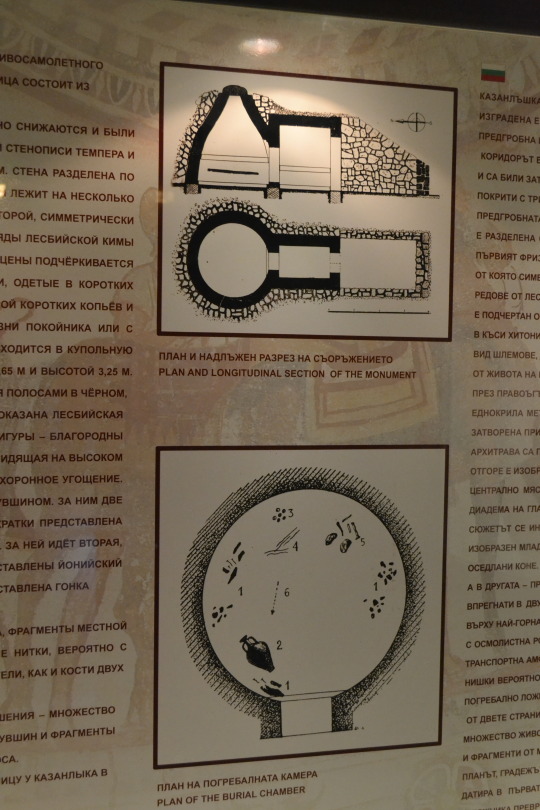

In Thrace, at least royal tombs are repurposed shrines (above: diagram and model of repurposed shrine-tombs). Macedonian Tombs were new construction meant to look like a shrine (faux-fronts, etc.). Also, Thracian kings’ bodies weren’t buried in their "tombs." Following the Dionysic/ Orphaic cult, the bodies were cut up into seven pieces and buried in unmarked spots. Ergo, their tombs are cenotaphs (below: Kosmatka Tomb/Tomb of Seuthes III, photos mine).

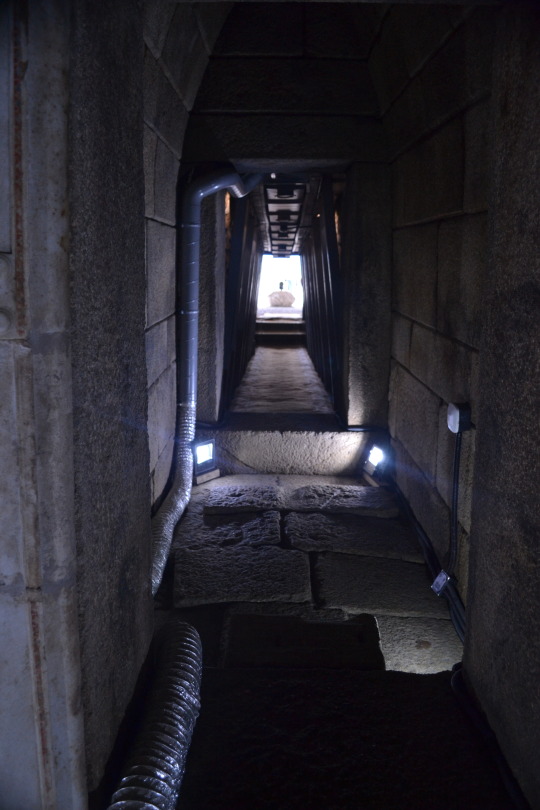
What they shared was putting absurd amounts of wealth into the ground in the way of grave goods, including some common/shared items such as armor, golden crowns, jewelry for women, etc. All this in place of community-reflective temples, as seen in the South. (Below: grave goods from Seuthes’ Tomb; grave goods from Royal Tomb II at Vergina, for comparison).



So, if some things are shared, others (connected to beliefs about the afterlife) are distinct, such as the repurposed shrine vs. new construction built like a shine, and the presence or absence of a body (below: tomb ceiling décor depicting Thracian deity Zalmoxis).

Aside from graves, we also find differences between highlands and lowlands in the roles of at least elite women. The highlands were tough areas to live, where herding (and raiding) dominated, and what agriculture there was required “all hands on deck” for survival. While that isn’t necessary for women to enjoy higher status (just look at Minoan Crete, Etruria, and even Egypt), it may have contributed to it in these circumstances.
Illyrian women fought. And not just with bows on horseback as Scythian women did. If we can believe Polyaenus, Philip’s daughter Kyanne (daughter of his Illyrian wife Audata) opposed an Illyrian queen on foot with spears—and won. Philip’s mother Eurydike involved herself in politics to keep her sons alive, but perhaps also as a result of cultural assumption: her mother was royal Lynkestian but her father was (perhaps) Illyrian. Epirote Olympias came to Pella expecting a certain amount of political influence that she, apparently, wasn’t given until Philip died. Alexander later observed that his mother had wisely traded places with Kleopatra, his sister, to rule in Epiros, because the Macedonians would never accept rule by a woman (implying the Epirotes would).
I’ve noted before that the political structure in northern Greece was more of a continuum: Thessaly had an oligarchic tetrarchy of four main clans, expunged by Jason in favor of tyranny, then restored by Philip. Epiros was ruled by a council who chose the “king” from the Aiakid clan until Alexandros I, Olympias’s brother, established a real monarchy. Last, we have Macedon, a true monarchy (apparently) from the beginning, but also centered on a clan (Argeads), with agreement/support from the elite Hetairoi class of kingmakers. Upper Macedonian cantons (formerly kingdoms) had similar clan rule, especially Lynkestis, Elimeia, and Orestis. Alas, we don’t know enough to say how absolute their monarchies were before Philip II absorbed them as new Macedonian districts, demoting their basileis (kings/princes) to mere governors.
I think continued highland resistance to that absorption is too often overlooked/minimized in modern histories of Philip’s reign, excepting a few like Ed Anson’s. In Dancing with the Lion: Rise, I touch on the possibility of highland rebellion bubbling up late in Philip’s reign but can’t say more without spoilers for the novel.
In antiquity, Thessaly was always considered Greek, as was (mostly) Epiros. But Macedonia’s Greek bona-fides were not universally accepted, resulting in the tale of Alexandros I’s entry into the Olympics—almost surely a fiction with no historical basis, fed to Herodotos after the Persian Wars. The tale’s goal, however, was to establish the Greekness of the ruling family, not of the Macedonian people, who were still considered barbaroi into the late Classical period. Recent linguistic studies suggest they did, indeed, speak a form of northern Greek, but the fact they were regarded as barbaroi in the ancient world is, I think instructive, even if not necessarily accurate.
It tells us they were different enough to be counted “not Greek” by some southern Greek poleis and politicians such as Demosthenes. Much of that was certainly opportunistic. But not all. The bias suggests Macedonian culture had enough overflow from their northern neighbors to appear sufficiently alien. Few Greek writers suggested the Thessalians or Epirotes weren’t Greek, but nobody argued the Thracians, Paiones, or Illyrians were. Macedonia occupied a liminal status.
We need to stop seeing these areas with hard borders and, instead, recognize permeable boundaries with the expected cultural overflow: out and in. Contra a lot of messaging in the late 1800s and early/mid-1900s, lifted from ancient narratives (and still visible today in ultra-national Greek narratives), the ancient Greeks did not go out to “civilize” their Eastern “Oriental” (and northern barbaroi) neighbors, exporting True Culture and Philosophy. (For more on these views, see my earlier post on “Alexander suffering from Conqueror’s Disease.”)
In fact, Greeks of the Late Iron Age (LIA)/Archaic Age absorbed a great deal of culture and ideas from those very “Oriental barbarians,” such as Lydia and Assyria. In art history, the LIA/Early Archaic Era is referred to as the “Orientalizing Period,” but it’s not just art. Take Greek medicine. It’s essentially Mesopotamian medicine with their religion buffed off. Greek philosophy developed on the islands along the Asia Minor coast, where Greeks regularly interacted with Lydians, Phoenicians, and eventually Persians; and also in Sicily and Southern Italy, where they were talking to Carthaginians and native Italic peoples, including Etruscans. Egypt also had an influence.
Philosophy and other cultural advances didn’t develop in the Greek heartland. The Greek COLONIES were the happenin’ places in the LIA/Archaic Era. Here we find the all-important ebb and flow of ideas with non-Greek peoples.
Artistic styles, foodstuffs, technology, even ideas and myths…all were shared (intentionally or not) via TRADE—especially at important emporia. Among the most significant of these LIA emporia was Methone, a Greek foundation on the Macedonian coast off the Thermaic Gulf (see map below). It provided contact between Phoenician/Euboian-Greek traders and the inland peoples, including what would have been the early Macedonian kingdom. Perhaps it was those very trade contacts that helped the Argeads expand their rule in the lowlands at the expense of Bottiaians, Almopes, Paionians, et al., who they ran out in order to subsume their lands.
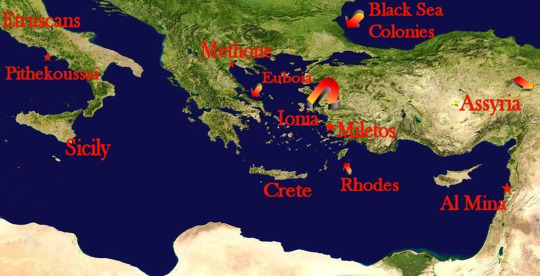
My main point is that the northern Greek mainland/southern Balkans were neither isolated nor culturally stunted. Not when you look at all that gold and other fine craftwork coming out of the ground in Archaic burials in the region. We’ve simply got to rethink prior notions of “primitive” peoples and cultures up there—notions based on southern Greek narratives that were both political and culturally hidebound, but that have, for too long, been taken as gospel truth.
Ancient Macedon did not “rise” with Philip II and Alexander the Great. If anything, the 40 years between the murder of Archelaos (399) and the start of Philip’s reign (359/8) represents a 2-3 generation eclipse. Alexandros I, Perdikkas II, and Archelaos were extremely capable kings. Philip represented a return to that savvy rule.
(If you can read German, let me highly recommend Sabine Müller’s, Perdikkas II and Die Argeaden; she also has one on Alexander, but those two talk about earlier periods, and especially her take on Perdikkas shows how clever he was. For those who can’t read German, the Lexicon of Argead Macedonia’s entry on Perdikkas is a boiled-down summary, by Sabine, of the main points in her book.)
Anyway…I got away a bit from Thracian-Macedonian cultural parallels, but I needed to mount my soapbox about the cultural vitality of pre-Philip Macedonia, some of which came from Greek cultural imports, but also from Thrace, Illyria, etc.
Ancient Macedonia was a crossroads. It would continue to be so into Roman imperial, Byzantine, and later periods with the arrival of subsequent populations (Gauls, Romans, Slavs, etc.) into the region.
That fruit salad with Cool Whip, or Jello and marshmallows, or chopped up veggies and mayo, that populate many a family reunion or church potluck spread? One name for it is a “Macedonian Salad”—but not because it’s from Macedonia. It’s called that because it’s made up of many [very different] things. Also, because French macedoine means cut-up vegetables, but the reference to Macedonia as a cultural mishmash is embedded in that.
---------------
* I’ve seen this personally between my first trip to Greece in 1997, and the new modern highway. Instead of winding around mountains, the A2 just blasts through them with tunnels. The A1 (from Thessaloniki to Athens) was there in ’97, and parts of the A2 east, but the new highway west through the Pindus makes a huge difference. It takes less than half the time now to drive from the area around Thessaloniki/Pella out to Ioannina (near ancient Dodona) in Epiros. Having seen the landscape, I can imagine the difficulties of such a trip in antiquity with unpaved roads (albeit perhaps at least graded). Taking carts over those hills would be daunting. See images below.


#asks#ancient Macedonia#ancient Thrace#ancient Epiros#ancient Thessaly#Argead Macedonia#pre-Philip Macedonia#Late Iron Age Greece#Archaic Age Greece#Thracian tombs#Macedonian tombs#Classics#tagamemnon#Alexander the Great#Philip II of Macedon#Philip of Macedon#women in ancient Macedonia#ancient Illyria#women in Illyria#Macedonian-Thracian similarities#religion in ancient Thrace#religion in ancient Macedonia
13 notes
·
View notes
Text









13 days of witches: the witches of Thessaly
"I have the gift of magic and the fire of prophecy in me. I have learned the incantations wherewith Thessalian witches pull down the bright moon, I know... the various saps that flow within trees and the power of deadly herbs… such as cruel Medea gathered and curious Circe." — Claudianus Claudius
They are the ancestors of the archetypal witch, foremothers of the lusty crone and the belle dame both. No outsider or foreign import, but a breed of homegrown sorceress blooming in the margin between civilization and the mythic wild, with roots deep-set into the wooded valleys and peaks of Thessaly, their home and haunting ground. In Thessaly rises both Othrys and Olympus, dwelling places of the titans and the gods; here great Chiron taught the secrets of magic and medicine to mortals-- even the warriors bred in Thessaly were healers, too. Like the witches themselves, it is wild, impassible, ungovernable, full of occult doings in unseen places. Here the witches walk alone, treading the roads at night without modesty or fear. At will they shed their forms to wander in the shapes of beasts and congregate among graves, spilling living blood and profaning ancient burials. They are dangerous and deeply wise, educated in whispered, moon-occluded, long-inherited things, wielding the double-edged blade of cure and poison at no one's bidding but their own. They traffic with gods without the sanction of priesthood, and straddle the bounds of science without deference. And when they gather themselves beneath the fullness of the moon, at their command she drops from the sky and into their waiting arms.
#13 days of witches#inspired by interluxetumbra's moodboard challenge#moodboard#witch aesthetic#witch#ancient greece#thessaly#thessalian witches#image credits:#Tamara Lichtenstein / Joanne Burke / Graham Butler / MadonnaOriente on Etsy /#Fellini Satyricon / Sacrificium store / Aki Pitkänen/Narikka Photography
28 notes
·
View notes
Text
Some really good news overshadowed by the tragedy with the floods in Larissa and the rest of Thessaly but
the ancient theatre downtown in Larissa was recently open again to an audience after 1700 years! The ancient theatre was built in the 3rd century BC and operated for 600 years until it was severely damaged from an earthquake in the 3rd century AD and stopped being used. In the 7th century, another earthquake destroyed it completely.
The theatre had a capacity of 10,000 people and it was dedicated to Dionysus.
It has been a well known historical attraction in Larissa, however now after some progress in the long restorations, it is becoming again a functioning theatre like all ancient theatres in Greece that are in a decent enough condition.
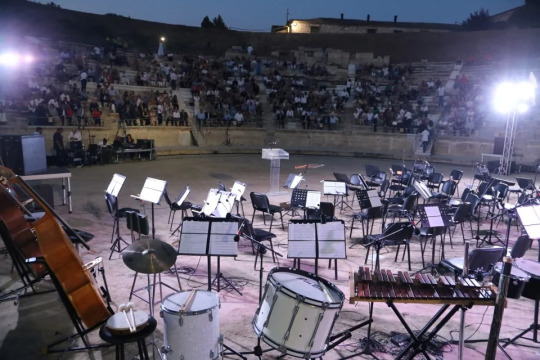
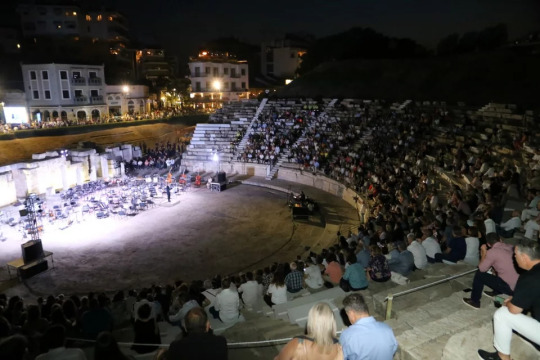
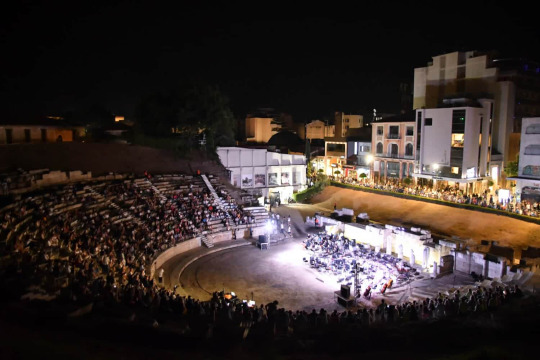
#greece#europe#theatre#ancient theatre#ancient greece#greek history#history#larisa#larissa#thessaly#mainland
111 notes
·
View notes
Text
Teutamides is my Glup Shitto.
#the cool guy who was super understanding to Perseus and helped him bury his grandfather?#not only that but he also made a shrine for said grandfather?#he’s a real one idc#he could’ve been hostile or exiled Perseus for this incident#especially since it happened in the funeral games for his own father#I think all mythology fans have their own glup shitto#greek mythology#ancient greek mythology#greek pantheon#perseus#Teutamides#Larissa#Thessaly#Acrisius#glup shitto
7 notes
·
View notes
Text
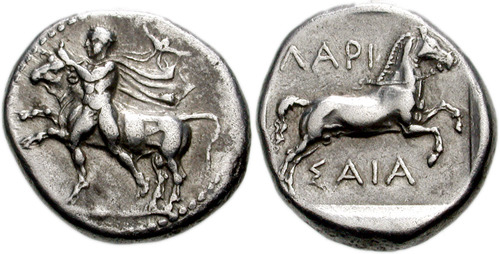
Coin of the Thessalian city of Larissa, minted in 440 BCE. On the obverse, a man wrestling a bull, perhaps representing Heracles' Seventh Labor (the struggle with the Cretan Bull). On the reverse, a bridled horse galloping. Thessaly was famed in antiquity for the excellence of its cavalry and the fine quality of its horses. Photo credit: Classical Numismatic Group, Inc. http://www.cngcoins.com
#classics#tagamemnon#Ancient Greece#Classical Greece#art#art history#ancient art#Greek art#Ancient Greek art#Classical Greek art#Thessaly#Thessalian art#coins#ancient coins#Greek coins#Ancient Greek coins#numismatics#ancient numismatics
55 notes
·
View notes
Text
So the book I'm reading keeps mentioning the witches of Thessaly, so I looked up a few and I came across this article Witches of Thessaly by Brian Clark. Who is Brian Clark? What authority does he have? I can only find reference to this one article and nothing else is pulling up. I'm very skeptical. I haven't read the article yet, but it's just sitting in a tab on my computer.
#anyone know anything#idk im just sitting here#helpol#witchblr#theres so many references to witches of Thessaly in ancient greece and rome#and im kind of surprised i havent heard of it before because I spent a good summer immersing myself in ancient greek texts
14 notes
·
View notes
Text
Coin of the Day #169 (10/20/2024)
A beautiful Thessalian coin…


Thessaly
AE20 - 6.94g
Magistrate Thera… 196-27 BC
Thessalian League
Obverse Head of Apollo right, laureate
Reverse ΘEΣΣAΛΩN
Athena Ionia walking right, brandishing spear and shield, ΘPA and owl above
BMC 49, Rogers 20
#coin of the day#ancient greece#thessaly#thessalian league#greek coins#coin#coins#numismatics#ancient coins
1 note
·
View note
Text
Greek, Geometric, Thessaly

Gold bracelet, Greece, 8th century BC
from The Yale University Art Museum
151 notes
·
View notes
Text
Somehow I missed this - last month the University of Thessaly tested the Mycenaean Dendra armour for combat by putting it on Greek Marines in an “11-hour simulated Bronze Age combat protocol”!
Not only did it prove battle-worthy, we now have THIS IMAGE🤯

Article: https://www.sci.news/archaeology/dendra-armor-12959.html
Study: https://journals.plos.org/plosone/article?id=10.1371/journal.pone.0301494
#ancient greece#experimental archaeology#dendra armour#dendra#dendra panoply#trojan war#iliad#greek mythology#greek myth#tagamemnon#archaeology#drawing prompt#warrior#achilles#study#ancient history
1K notes
·
View notes
Photo

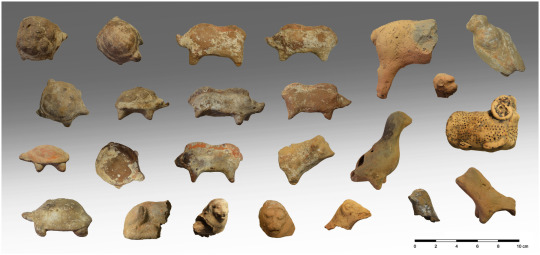


Greek Temple Complex Reveals Thousands of Votive Figurines
Archaeologists excavating a hilltop sanctuary on the Aegean Sea island of Kythnos have discovered “countless” pottery offerings left by ancient worshippers over the centuries, Greece’s Culture Ministry said Wednesday.
A ministry statement said the finds from work this year included more than 2,000 intact or almost complete clay figurines, mostly of women and children but also some of male actors, as well as of tortoises, lions, pigs and birds.
Several ceremonial pottery vessels that were unearthed are linked with the worship of Demeter, the ancient Greek goddess of agriculture, and her daughter Persephone, to whom the excavated sanctuary complex was dedicated.
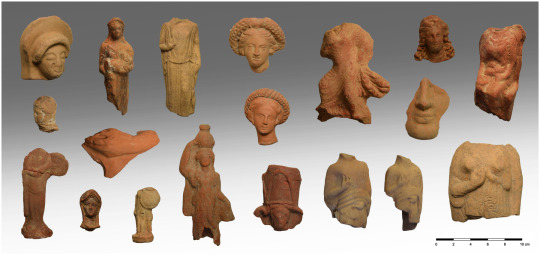
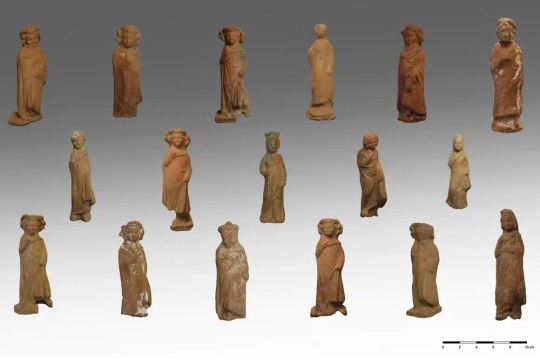
The seaside site of Vryokastro on Kythnos was the ancient capital of the island, inhabited without break between the 12th century B.C. and the 7th A.D., when it was abandoned for a stronger position during a period of pirate raids.
The artifacts came from the scant ruins of the two small temples, a long building close by that may have served as a temple storeroom and a nearby pit where older offerings were buried to make space for new ones. The sanctuary was in use for about a thousand years, starting from the 7th century B.C.



The excavation by Greece’s University of Thessaly and the Culture Ministry also found luxury pottery imported from other parts of Greece, ornate lamps and fragments of ritual vases used in the worship of Demeter and Persephone at Eleusis, an ancient Athens suburb.
It is unclear to what extent the site on Kythnos was associated with Eleusis — one of the most important religious centers in ancient Greece, where the goddesses were worshipped during secret rites that were only open to initiates forbidden to speak of what they saw. The sanctuary at Eleusis is known to have owned land on the island.
Kythnos, in the Cyclades island group, was first inhabited about 10,000 years ago. Its copper deposits were mined from the 3rd millennium B.C., and in Roman times it was a place of political exile.
The excavations are set to continue through 2025.
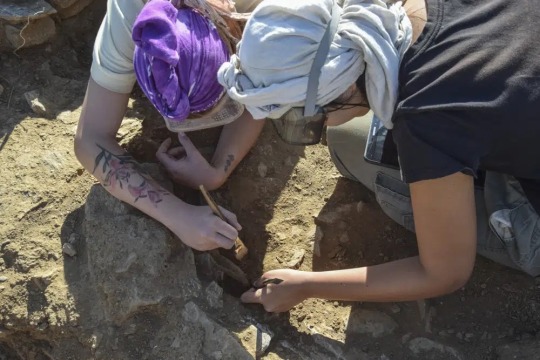
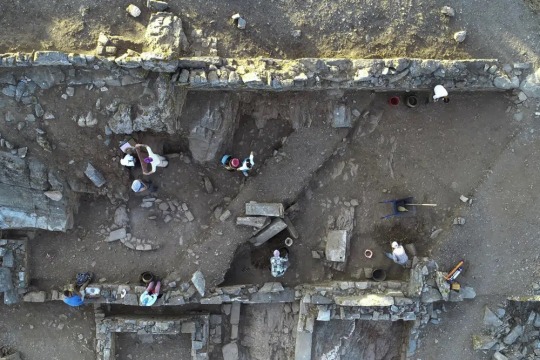
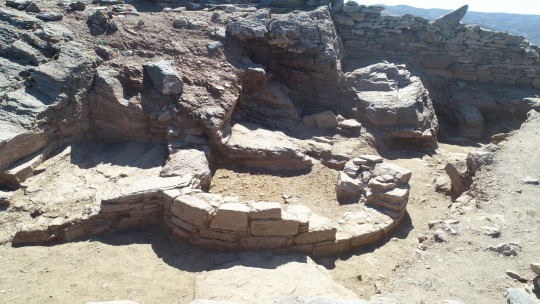
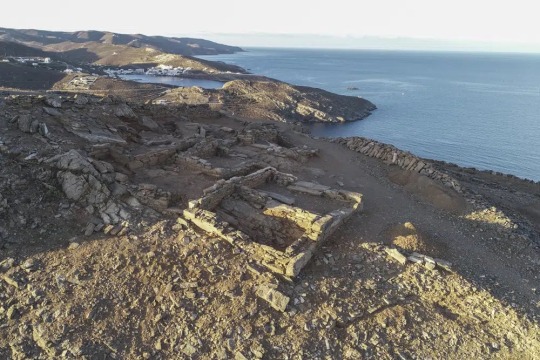
#Greek Temple Complex Reveals Thousands of Votive Figurines#island of kythnos#pottery#pottery offerings#ancient artifacts#archeology#archeolgst#history#history news#ancient history#ancient culture#ancient civilizations#ancient greece#greek history#greek art#long reads
530 notes
·
View notes
Text
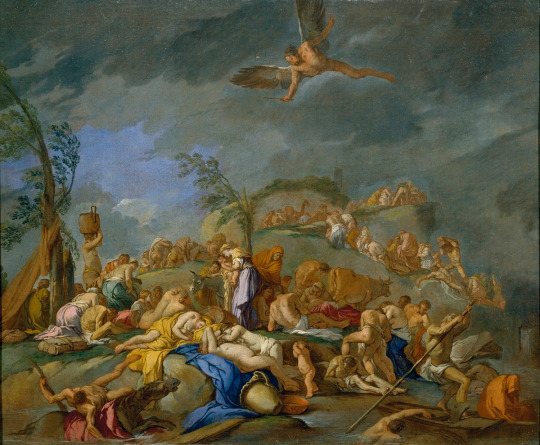
Deucalion’s Flood by Giulio Carpioni
#deucalion#flood#deluge#art#giulio carpioni#pyrrha#prometheus#zeus#greek mythology#ancient greece#ancient greek#angel#angels#gods#mankind#mythology#religion#ark#boat#chest#floods#classical antiquity#animals#humanity#mount parnassus#thessaly#mediterranean#europe#european#rebirth
22 notes
·
View notes
Text
The Portrayal of Womanhood in A Game of You
I’ll be honest with you: Writing about The Sandman with a focus on (queer) women surely feels different in light of the recent allegations.
This meta has been languishing in my drafts for a long time, and since I’m currently clearing the pile, I will still publish it. Mostly because these views are mine and not someone else’s. And also because they’re critical to a degree. However, if you feel that these are topics that you currently find hard to engage with, this is the exit sign (I totally get it).
With that out of the road, let’s talk about the women of A Game of You (and why it was always one of my least favourite arcs, despite the fact that my literary and thematic preferences should have made it one of my favourite ones)…
Gender roles are a central theme in A Game of You. Before the arc even moves into these themes on a deeper level, we already get this:

Barbie tells Wanda that she wasn’t allowed to read comics when she was a young girl. And that immediately struck a chord with me upon my first reading as a teenager: I was allowed to read comics, but I still remember getting the side-eye, especially from boys. Somehow, you didn’t belong to their club (even if you arguably knew more about Batman than they did 🤣). The reason Barbie gives us is that reading comics supposedly rendered her “unladylike” (yes, comics were considered “boyish”, at least when I was a teenager, and this is exactly the time we’re talking about here). But it’s not just about how a girl is supposed to act—it’s also about actively excluding her from something that’s only for men/boys. And while the topic of, “What’s a girl supposed (and allowed!) to be like?” isn’t something either particularly dwell on in that moment, Wanda faces the struggle of having to define and fight for her womanhood daily: As a trans woman, she feels resistance on a constant basis. When she talks about Weirdzos from the Hyperman comics, this is actually a nod to DC’s Bizarro, who could be described as Superman’s shadow (there’s a whole story why they were called Weirdzos instead of Bizarros in The Sandman, but that’d lead too far here. You’ll probably find it on Google).
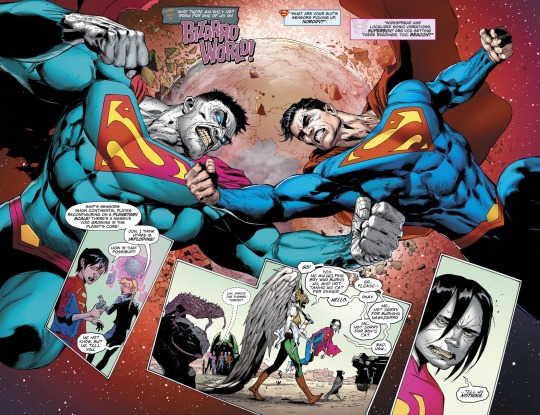
Close enough to the “real thing”, but always “slightly off”
And Wanda carries the shadow of her biology. All the time. There’s no escape for her, no respite, no true support.
We also see this in a scene with Hazel, one of Wanda's neighbours who lives in a lesbian relationship with her girlfriend Foxglove. Hazel noticed that Wanda has "a thingie." Despite the fact that a lot of “weird” things are happening in those panels, part of that is definitely that Wanda has not fully (in Hazel’s eyes) transitioned:

What is she, exactly (not who)?
And that question gets answered very painfully when Wanda, Hazel, Foxglove, and Thessaly come together to free Barbie from being trapped in the Dreaming. Thessaly is sure she can defeat the Cuckoo that holds Barbie captive. However, she needs menstrual blood to perform a ritual that will allow them to traverse the Moon Road into the Dreaming. During this process, Thessaly insensitively refers to Wanda as a man and prevents her from joining the journey with Foxglove and Hazel (and no, this isn’t about “Thessaly the TERF”—I already made my position on that clear and think that whole discussion needs a lot more nuance than fandom is often willing to engage in).
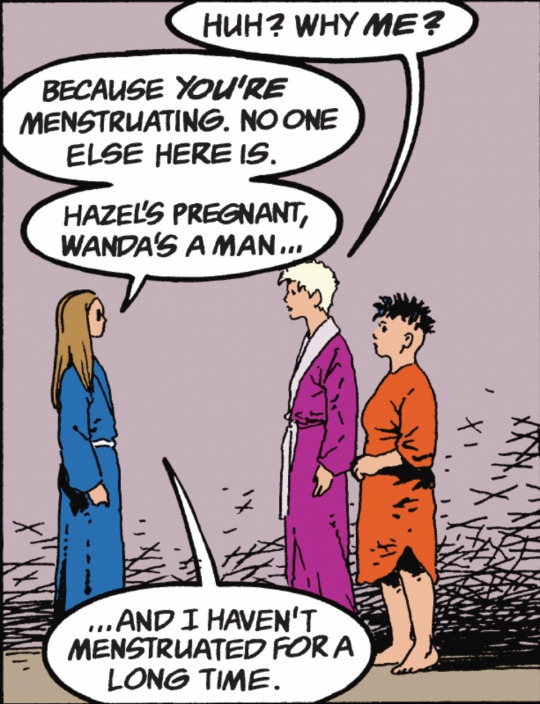
Maiden, Mother and Crone
Thessaly's statement, "This isn’t your route. It can’t be," further highlights the discrimination Wanda faces on a daily basis. She “isn’t” seen as a woman now, and she “can’t” ever be, even if she had reassignment surgery—Wanda would still be seen as a man by the ancient powers that be.
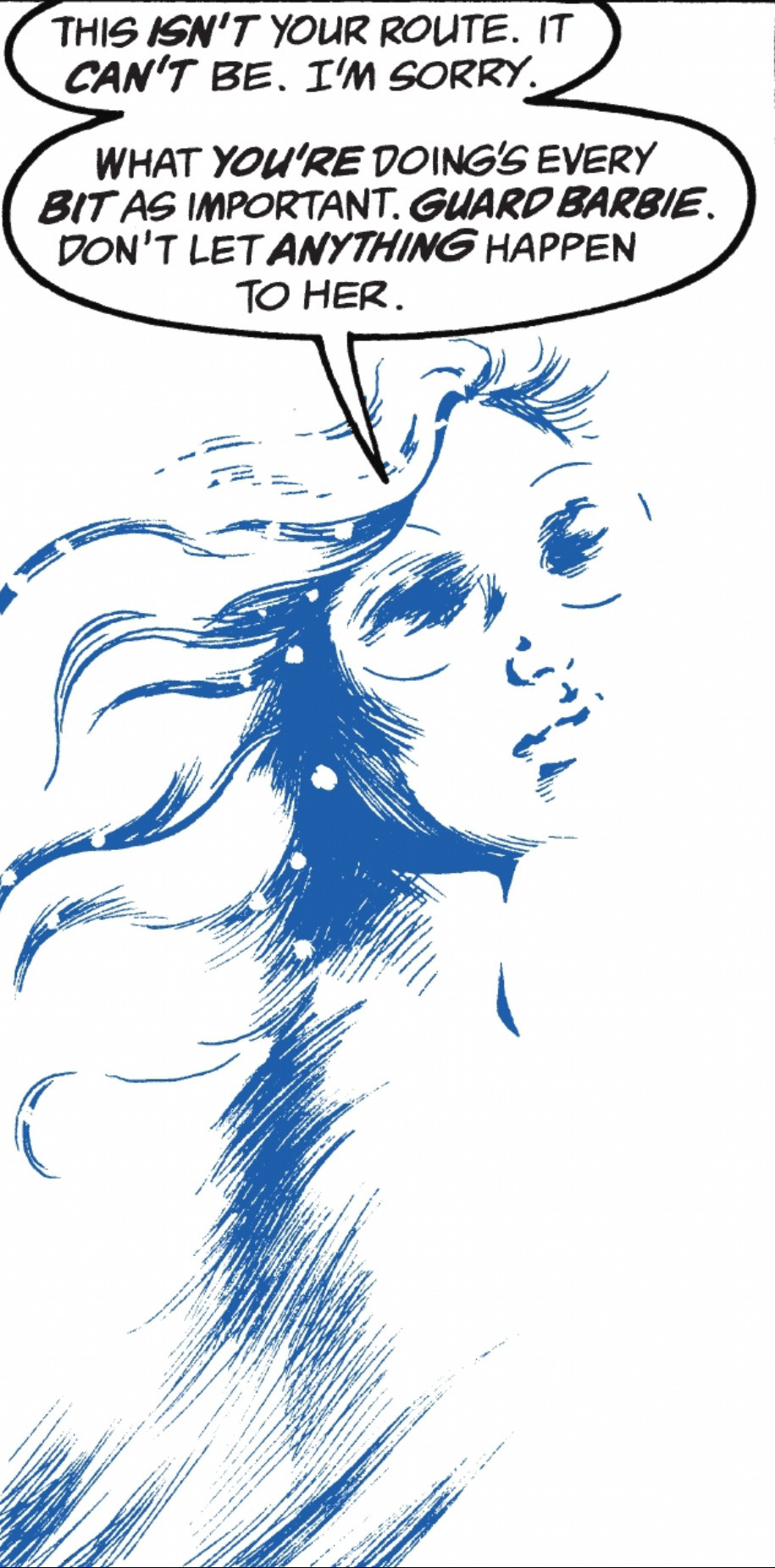
Wanda's struggle, more than any other character's, highlights the ongoing conflict between self-identity and societal perception of women. And that’s unfortunately still a struggle most women face. But Wanda’s character is particularly poignant because she is repeatedly forced to reaffirm her sense of self, only to be torn down again and again. Even Barbie, who always supports her and would probably never knowingly hurt her, says this when Wanda reveals her childhood name:

“Alvin? That's your real name?"
Please imagine what it must feel like if even the ones closest to you refer to your dead name as your “real” name, even if it’s without malicious intent (of course Barbie makes good on that later, but…).
Wanda can never truly find comfort in anyone. She is constantly confronted with the disparity between her self-perception and how the world views her. Ultimately, Wanda's exclusion from entering the Dreaming (and there’s more symbolism in that than you can shake a stick at—not just because she’s denied her womanhood, but also because she is denied entering a place of hope and possibility, and not least because she is denied being capable and having agency: Thessaly repeatedly acknowledges Wanda is important, and that she needs her help. But that’s on her terms, not Wanda’s) leads to her tragic death: The storm caused by drawing down the moon destroys the apartment where Wanda remains to watch over Barbie’s body.
And that’s why Wanda’s arc in the comics will always stay problematic to me (I don’t know how optimistic I can be for the TV series, because we’ve already seen her headstone in BTS shots, even if her overall arc seems to have changed): Dream grants Barbie a boon, which she uses to save the women in the Dreaming, but Wanda is not among them. There is no saving her—not in this world, not in any other.
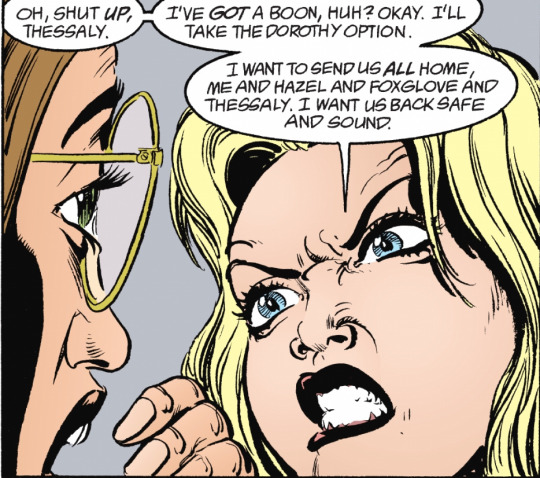
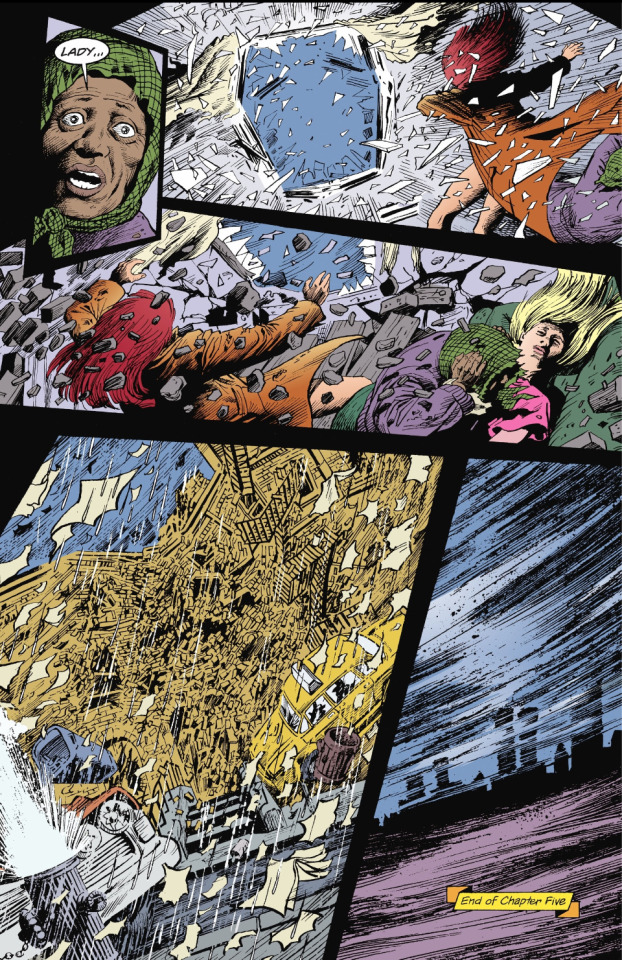
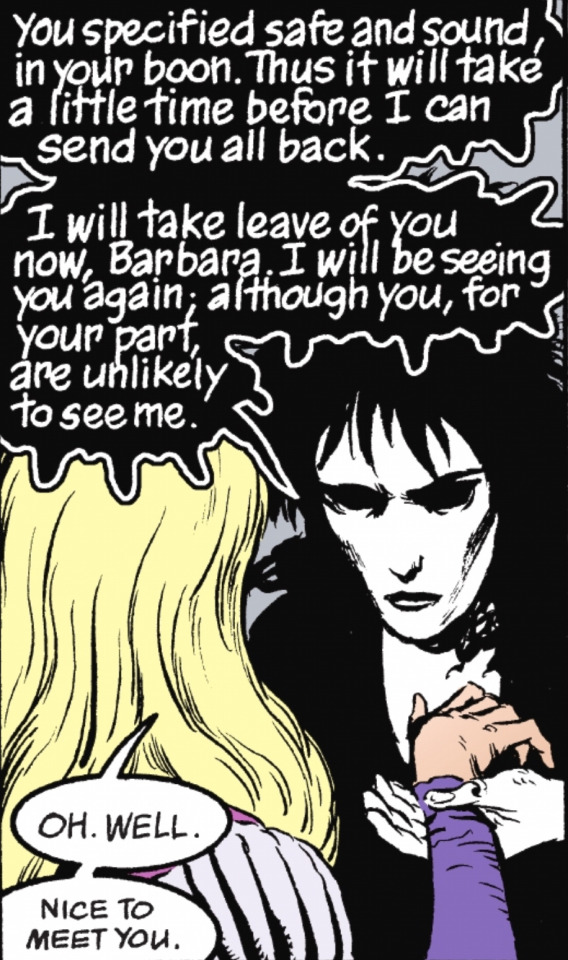
Wanda's conservative parents bury her with her deadname Alvin Mann (and her second name adds insult to injury, because it is the German spelling of “man”, as in “male”. And again, I’m somewhat glad they have changed this for the series, as seen on said headstone, because I never got why choosing that name was necessary in the first place. Or let’s say: I get it, but I don’t think it was needed and was layered on too thick. Sometimes subtle does it, sorry).
Why is Wanda so consistently shamed, while Hazel and Foxglove's lesbian relationship is regarded not a big deal (I’m obviously not insinuating it should be, see my disclaimer at the bottom of this post)? Although I have to admit there are things about that one that always rubbed me up the wrong way, too: The dumbing down of Hazel (honestly, most of us were not that clueless about reproduction in the 80s and 90s, lesbians or otherwise), the play on butch/femme stereotypes to then clumsily try to turn them on their heads (which did not work for me), the still somewhat male gaze applied to Foxglove (she didn’t have to sleep naked with her tits on display, did she?), the implication that all women somehow end up as mothers (if they don’t end up dead), even if just “accidentally”… There’s a whole lot to be said about the topic of motherhood, and how it gets instrumentalised in several Sandman arcs, but maybe that’s for another time...
To explore that question, I want to have a closer look at Barbie, who is a (in my view, often clumsy) stand-in for the gender-identity of many (CIS) women.
A quick throwback to The Doll’s House
The first signs of Barbie's identity crisis don't appear in A Game of You, but rather in The Doll's House. She is introduced as one half of “Ken-Barbie”: They finish each other's sentences, Barbie lacks a distinct personality and is completely overshadowed by being a “traditional wife” (maybe not the type of trad wife we think about today, and yet…). The fact that she and Ken share names with plastic dolls underscores the artificial nature of their identities and their relationship.
Barbie's dream-life always felt more authentic and meaningful to her than her waking reality—that’s why she is only a shell of herself when she can’t dream (after the vortex interlude with Rose Walker). She is passive, conforms to her father's expectations of being "ladylike" and adheres to “good” CIS- and heteronormative behaviour. And then, after her divorce, she feels uprooted, shows little motivation and relies on Wanda for support. Freeing herself from her shackles could have been a story of reclaiming her power without the layer of implied loneliness (I’ll get to that). Instead, she needs to suffer for a bit…
Barbie being trapped in her dream world also traps her in a state of passivity: Dreams are not real. You can make them real, but that’s not what she does—they are a maladjusted escape for her. And yet (or maybe rather “because”), instead of directly confronting and fighting the Cuckoo, Barbie smashes the Porpentine (much to the Cuckoo's delight).
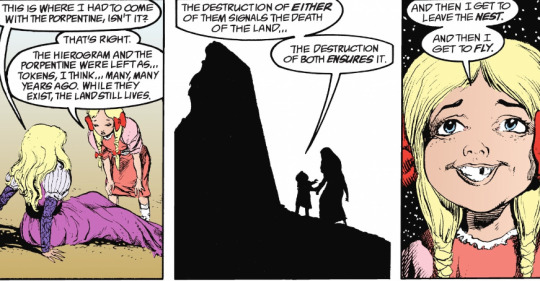
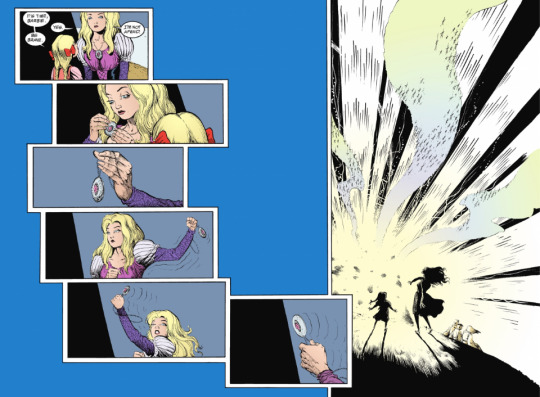
Upon waking…
Upon waking, Barbie's personality hasn't changed much from the woman we first met. When she goes to Wanda’s funeral, she struggles to defend Wanda from her transphobic aunt despite trying.
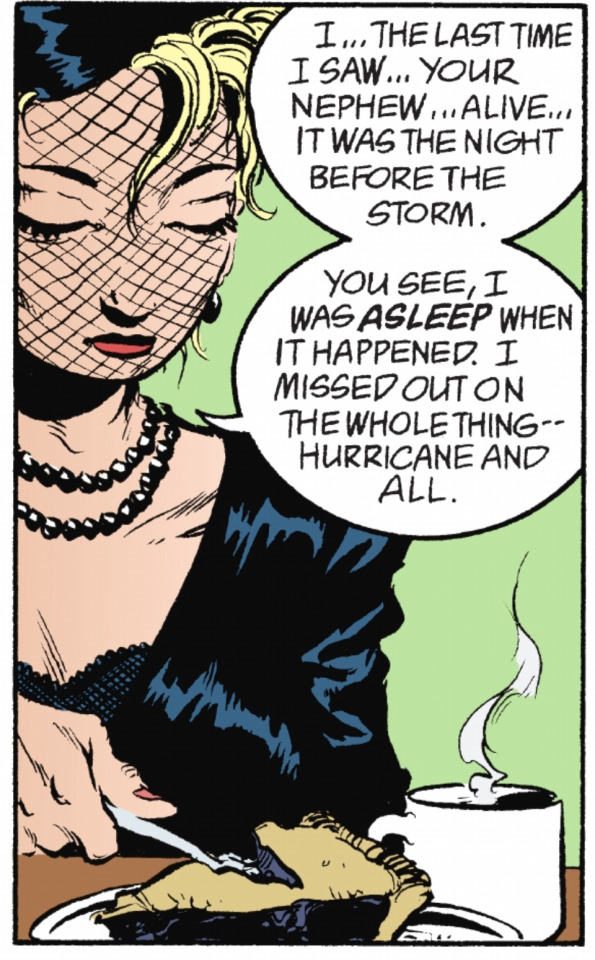
However, she engages in a small but significant act of rebellion by crossing out "Alvin" on Wanda's headstone with her favourite lipstick and writes her real name instead.

Barbie then recalls a dream she had while traveling to Wanda's funeral. In this dream, she sees Wanda not as she was in life, but as an idealised version of herself—soft, more curved, and wearing a pink dress. Death stands beside Wanda, symbolising that she is recognised for who she truly is.
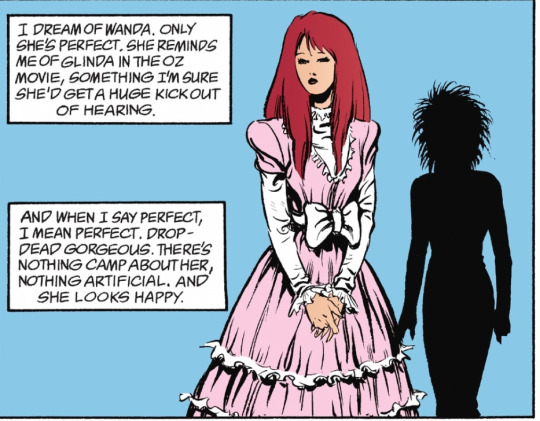
And I get it: The idea was to say, “She was always a woman, even to the cosmic powers that be. Eat that, Thessaly and everyone else.” But there’s also the part of me that wants to say, “You know what? She was good the way she was. Perfect in her imperfection. We didn’t need to affirm her womanhood by showing her as a stereotypical woman.” The use of “perfect” and “drop-dead gorgeous” always really rubbed me up the wrong way in relation to the way she was portrayed in that panel. Because it portrays a stereotypical woman: That’s what you look like if you need to/want to pass. And this applies, sadly enough, to all women in one way or another, no matter what gender we were assigned at birth. But if that scene holds meaning to people, I also get it. My more critical take on it is maybe down to my own history (again: disclaimer at the bottom of this post).
Simultaneously, the destruction of the Land in the Dreaming grants Barbie a newfound independence. She is now alone, without her best friend or the friends of her dreams, but these losses have given her freedom. And for a moment, loneliness becomes the ultimate resolution to Barbie's identity conflict. And I found that idea horrible, I’ll be brutally honest with you:
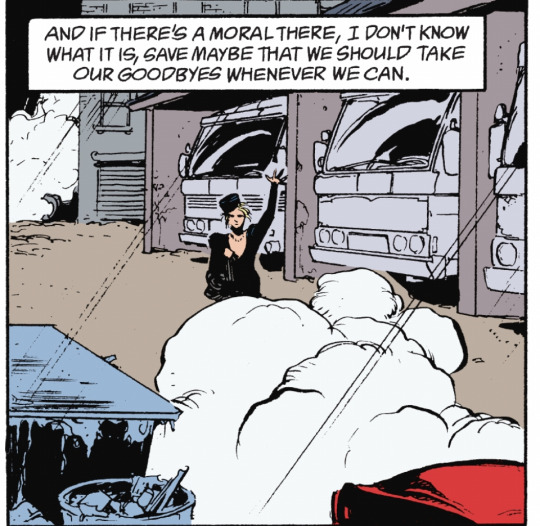
On the final page of A Game of You, Barbie is shown alone, waiting for a bus to an unknown destination. She reflects on her dream of Wanda, where she had the chance to say goodbye to her past life. For a moment, she stands rigidly still, and that moment feels… really long? Separated from her past and facing an uncertain future, she is free from anyone's expectations or desires. And maybe, in that simplicity, she finds freedom.
And maybe, A Game of You challenges the idea that we have full control over our identities. Our self-perception and how others perceive us are always influenced by external factors. And somewhat, I could never quite shake the feeling the story equates the removal of the ties that bind us (in this case: relationships) and/or death with freedom: Wanda only fully realises her identity in death, and Barbie feels most liberated when she is free from past entanglements and future obligations. Whether that notion is truly rejected in the end is probably down to the reader: Barbie turns and runs towards her bus, heading into a future that, while uncertain, maybe also holds a glimmer of hope. Unfortunately, none of the women of The Sandman get off particularly well in that department, and that is a common theme…
Disclaimer: I write this as a CIS bisexual woman in her 40s who has been in relationships with both women and men for 30+ years. Two of them led to marriage/civil partnership: One with a CIS woman, also bi (we were together for 10 years, 3 of them in a CP), one with my now husband (CIS straight man, married for 10 years, together longer, and we have a kid together). I don’t need to tell you this, but I am because I think it is important to disclose my own bias and experiences as a queer woman in the 90s, which include coming out, experiencing bi-erasure and misogyny from both inside and outside the LGBTQ+ community. As such, they will definitely colour the way I read and interpret A Game of You.
#the sandman#sandman#dream of the endless#morpheus#the sandman comics#wanda#Wanda sandman#sandman meta#thessaly#Thessaly sandman#Barbie sandman#hazel and foxglove#a game of you#hazel#foxglove#cuckoo sandman#the sandman barbie#sandman spoilers#the cuckoo the sandman#the sandman meta#queue
72 notes
·
View notes
Text
Demeter: Beneath the Earth Part 2, Dionysus
Demeter can often be seen as one dimensional when looking at a “modern re-telling” version of her Homeric Hymn. I’ve encountered many people outside the faith who, if they even know of her, know of her as a strict and prudish mother.
We know that is far from the truth, from her holidays and hymn encouraging crude jokes and language, to her affair with mortal man, her lack of being married in it all (though debated), and her cults likely uses of hallucinogenic drugs, she is far from prudish.
Come in Dionysus, one who is seen as perhaps her polar opposite in modern interpretation. Many see him as a God of pure ecstasy, of partying of lively drinking, and of being a bit lazy in other fields. This also is far from true- friend of the Temple @thedansemacabres made a post about a year ago about Dionysus Hestios, an obscure epithet of Dionysus that shows us his association with home and hearth. And while this may be more presumptive, I also believe that he has a “cozy” side because of the connections to wine and relaxation. Either way, he has many traits that are not well known too modern media.
They both, like all of the Gods, have many aspects to acknowledge and personality to spare. We see duality in many of them; Apollo with plague and medicine being a great example. I believe this is because nature is full of oppositional forces, and the Gods exemplify and guide nature. Nature allows for wind to calm us, or to destroy cities, for example. This is just like the Gods, who in mythology aided us, but also could destroy us.
Demeter and Dionysus are, in my perspective, heavily intertwined. We can see in agricultural holidays that they are both worshipped together- Demeter receiving the first crops, first vegetables, and Dionysus receiving the first grapes or first fruits. In conjunction with their agricultural associations, they both are deities of fertility.
The pairing of Dionysus and Demeter is not uncommon, given the agricultural connections to both deities, a point reinforced by the title Karpios (deriving from karpos ‘fruit’) given o Dionysus. The cult of both deities, it is often states, was very popular in Thessaly..
Religion and Society in Ancient Thessaly by Maria Mili
At their cores, Dionysus and Demeter are both deities of agriculture, and have been connected by this string since this beginning. This is what ties them together the most, and Dionysus’s worship in agriculture is often overlooked in favor of his place in society and culture as the God of Wine and Ecstasy- and please do not misunderstand, these are vital parts of him and are deserving of all their celebrations. I believe that the specific ties to agriculture deserve just as much recognition, he is not just the God of consuming wine, but the God of its creation from grape to wine.
Haloa is a festival that honors Demeter and Dionysus as gods of harvest and fertility. This festival ties them by fertility- the event was celebrated with a feast, genitalia shaped cakes, dancing, and ritual obscenity. This ties into the “fun” side of Demeter that also deserves it’s recognition, her duality is just as important as any others and it is very prevalent in history and mythology. And as a fertility rite, it was likely not just of the human fertility- but of the lands fertility.
While it is heavily debated, in UPG and in many academic texts and research, Demeter tends to have an association with some hallucinogenic and of course the poppy flower- and thus poppy seeds that produce opium. This connects them to not just the serious nature of agriculture, but to the enlightening or jovial nature of drug use. They also could have connections in wrath or reaction, or at the very least intertwined enough to be mentioned together in this way;
“For whatsoever things vex Demeter, vex also Dionysos; for Dionysos shares the anger of Demeter.”
Callimachus, Hymn 6 to Demeter 65 ff (trans. Mair)
Lastly, I'd like to briefly touch on the idea that Demeter is a parent of Dionsyus. This comes from Bibliotheca Historica. There are varying ways to interpret this possibility- for one, we can take it literally, that there were/are worshippers who believe that Zeus and Demeter are the parents of Dionsyus. Another interpretation could be more metaphorical, Demeter is the Goddess of the Harvest- of all harvest, so a God that is in that category, as Dionsyus is, is a metaphorical child or continuation of Demeter and her work.
The deities are capable of much more than we will ever know, and they have much more mythology and history than we will ever recover. So, we may never know the specifics of what we desire, but we can make educated guesses, work towards divination, and on a grander scale keep up with new archeological finds. Ultimately, it’s important as a worshipper to research and understand how multifaceted every being we encounter is, including and especially the Gods.
#demeter#hellenic polytheism#hellenic polythiest#hellenic deities#hellenic pagan#hellenic worship#temples post#dionysus#information#Demeter Beneath The Earth
28 notes
·
View notes
Photo








Golden Ancient Greek Jewellery
Golden diadem from the Thessaly / Karpenisi Treasure, 3rd-2nd century BC. Benaki Museum
Necklace with semi-precious gemstones and the head of a lynx on one side, Athens, 1st century BC. Benaki Museum
Ring with the depiction of a young man about to throw a fishing net, Rhodes island, 350 - 325 BC. Archaeological Museum of Rhodes
Attic red-figure pelike depicting the gift giving custom to the embellished bride the day after the wedding. It is attributed to the painter hired for the wedding, 330 - 315 BC, Athens. National Archaeological Museum
Heavy golden diadem with a Heracles knot, Thessaly / Karpenisi Treasure, 3rd-2nd century BC. Benaki Museum
Earrings with bull heads and acorns, Ancient Lete (Derveni) of Thessaloniki, 330 - 300 BC. Archaeological Museum of Thessaloniki
Earrings with God Eros, Athens, late 4th century BC. Benaki Museum
Necklace from the Thessaly / Karpenisi Treasure, 3rd-2nd century BC. Benaki Museum
#greece#ancient greece#ancient greek art#fashion#jewelry#jewellery#greek culture#athens#thessaloniki#rhodes#sterea hellas#central greece#macedonia#dodecanese#benaki museum#archaeological museum of rhodes#national archaeological museum#archaeological museum of thessaloniki
202 notes
·
View notes
Photo

Hippocrates
Hippocrates was born on the Greek island of Kos in the 5th century BCE, and he became the most famous physician in antiquity. He established a medical school on the island, wrote many treatises on medical matters, and is, through his systematic and empirical investigation of diseases and remedies, credited with being the founder of modern medicine.
Biographical Details
Information regarding Hippocrates is patchy and unreliable. He was perhaps born c. 460 BCE, but details of his life were speculated upon even in ancient times. One of the oldest sources is the Life of Hippocrates credited to Soranus of Ephesus, himself a physician, who lived in the 1st and 2nd centuries CE. Soranus' method of quoting from now lost earlier texts has been an invaluable source of information on ancient medicine. He states that Hippocrates knew several 5th-century sophists, notably Gorgias of Leontini, and was taught medicine by both his father and Herodicus of Selymbria, a gymnastic trainer. We also know that Hippocrates set up and ran a school of medicine on Kos.
Plato mentions Hippocrates in his Protagoras, suggesting that he worked for fees and believed the body should be treated as a whole (Phaedrus). The Roman scholar and medical writer Cornelius Celsus claims that Hippocrates was the first to separate medicine from philosophy, and other ancient sources also suggest that Hippocrates believed in the importance of diet and exercise for a healthy body. Soranus goes on to inform us that Hippocrates travelled throughout his life and died at Larissa in Thessaly, c. 370 BCE.
In antiquity, many legends arose of Hippocrates' great talents but most of these are likely pure invention. He reportedly discovered that King Perdiccas II of Macedon's health problems were down to lovesickness, he eliminated the plague that hit Athens in 430 BCE by burning fires everywhere, and he treated the philosopher Democritus whom everybody thought mad (not without some justification). Hippocrates had three sons who carried on his work - Thessalus, Dracon, and Polybus.
Continue reading...
37 notes
·
View notes